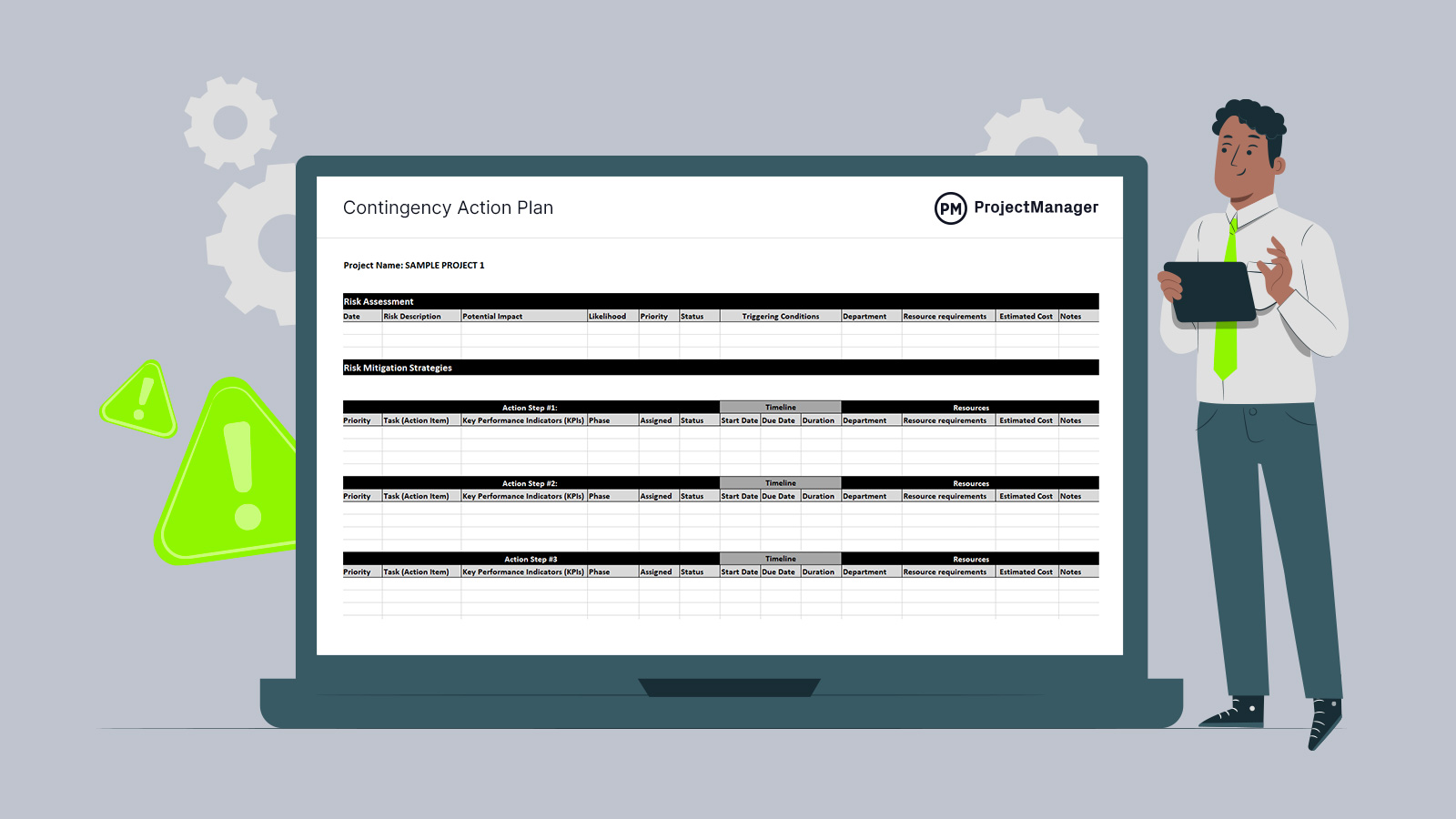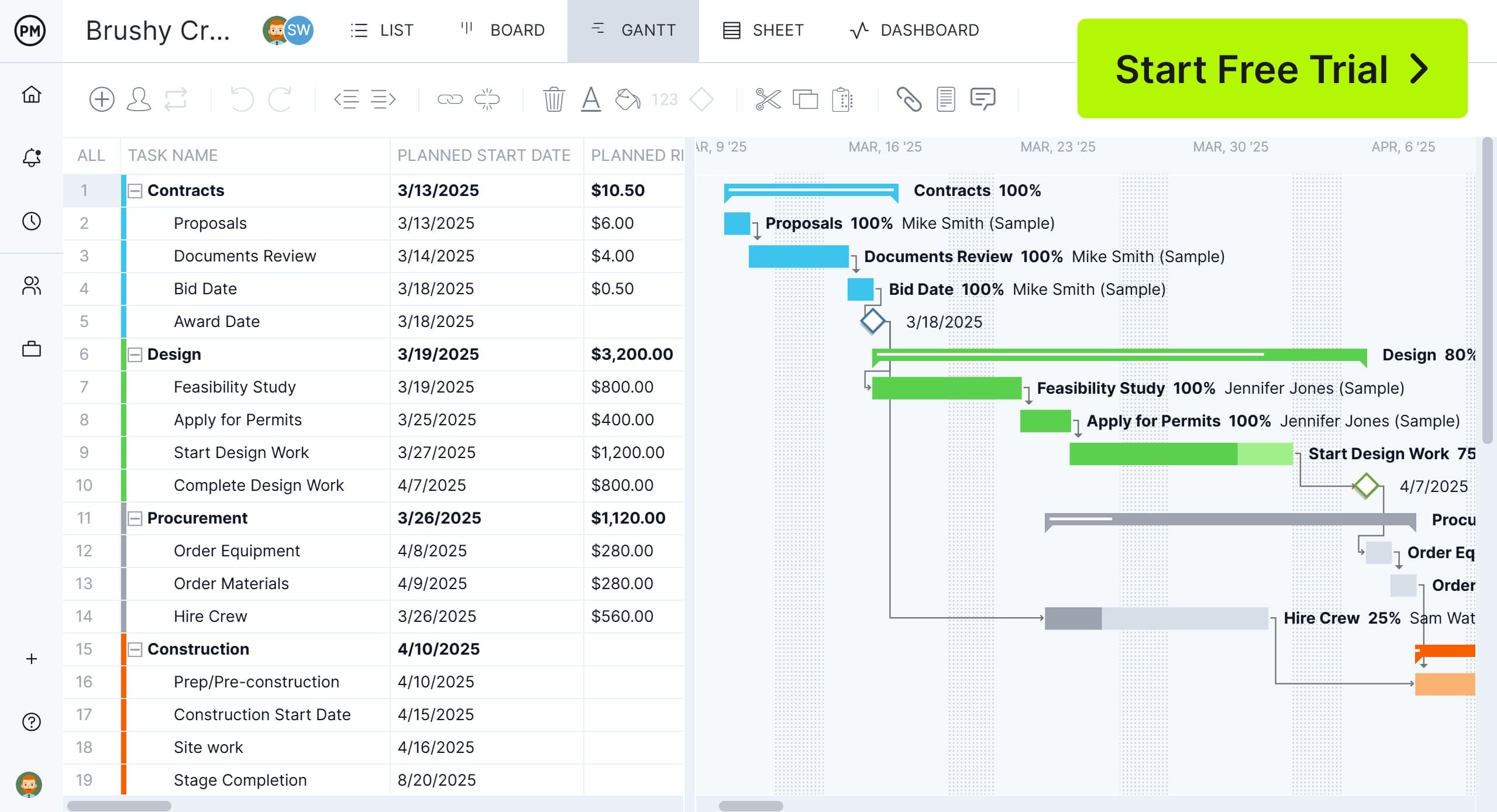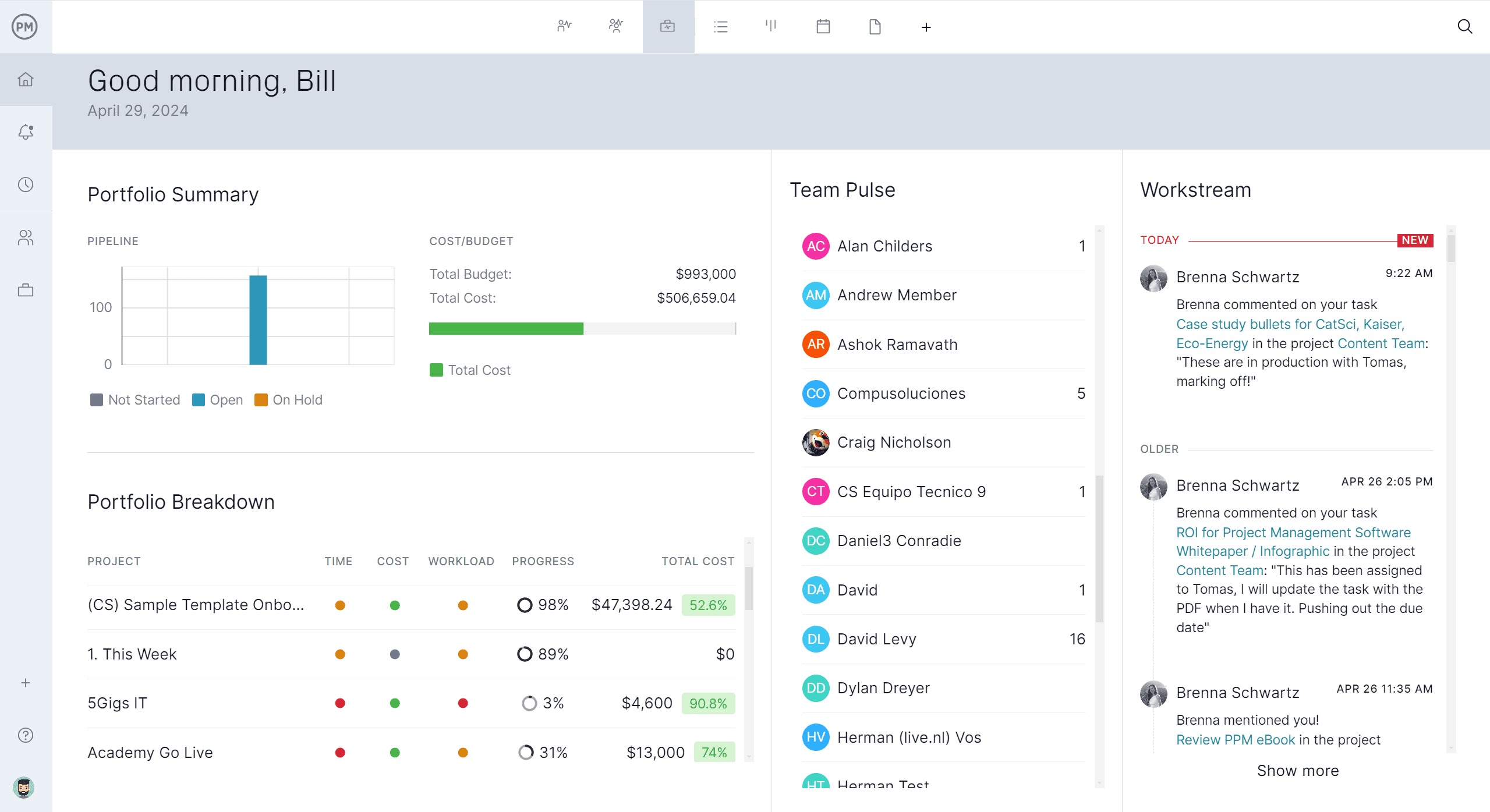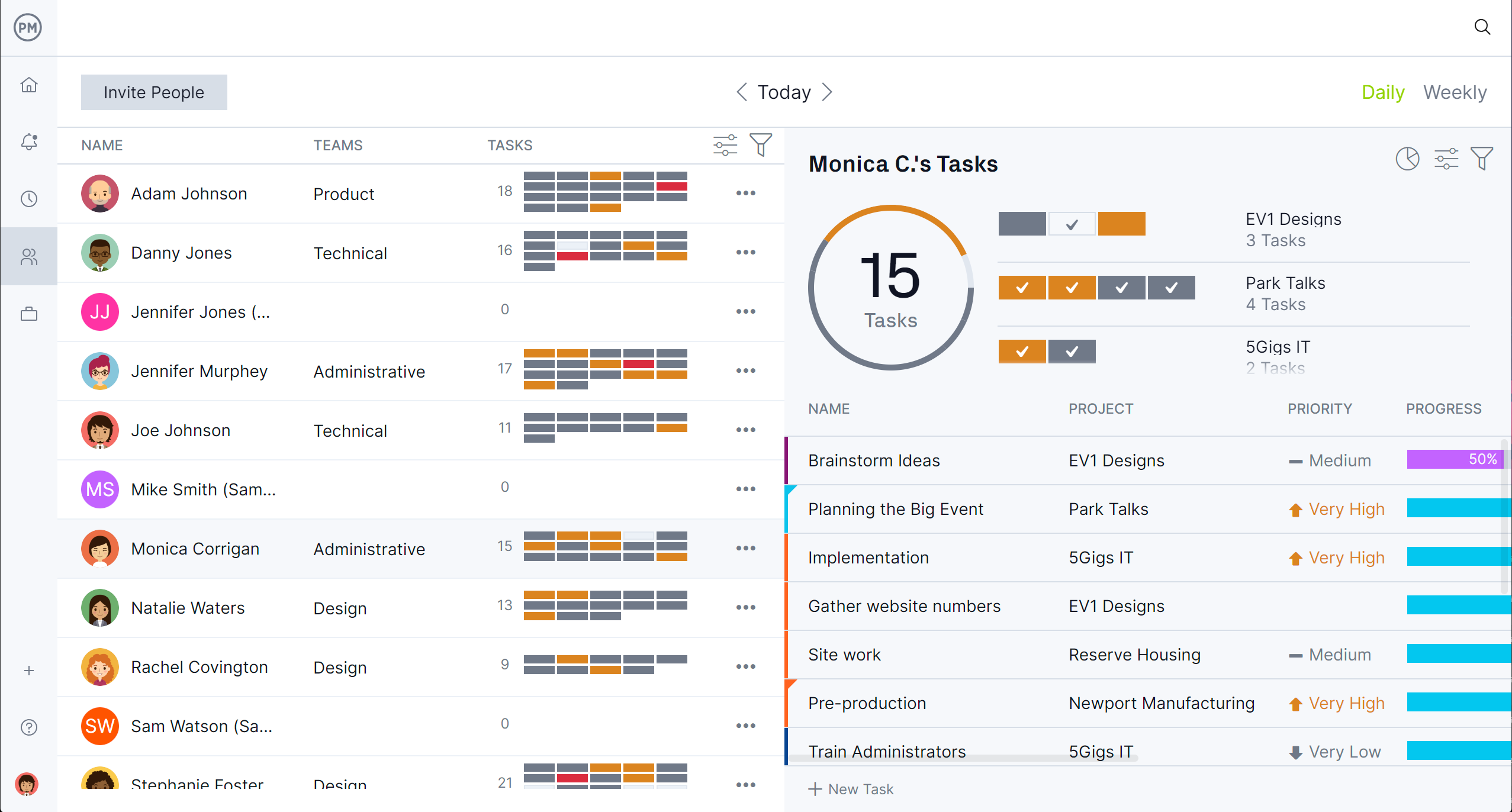Projects might have a roadmap, but when executed, they rarely go as planned. Internal and external factors can impact the project’s scope, budget, schedule and more. To address these issues before they even occur falls under project contingency.
Let’s start by defining project contingency and what makes up a contingency plan. Then, we’ll show how to execute that plan to avoid scope creep, budget overruns and schedule delays. Finally, we’ll share a few free templates to help facilitate the process.
What Is Project Contingency?
Project contingency refers to a reserved amount of time, money or resources set aside to address unexpected events or uncertainties that may arise during a project. It acts as a buffer to manage risks, deal with unforeseen challenges and ensure the project remains on track despite disruptions.
The purpose of project contingency is to provide a financial or time cushion to handle identified and unforeseen risks. It also helps to cover unexpected expenses without jeopardizing the project’s financial health. This allows for extra time to accommodate delays or unplanned tasks. It also reassures stakeholders that the project is prepared to handle uncertainties.

Get your free
Contingency Plan Template
Use this free Contingency Plan Template to manage your projects better.
Get the Template
Whether applying a cost contingency, time contingency or resource contingency, when the time comes to implement a contingency plan, project management software will be essential. That’s because they have Gantt charts that can set the initiative to a timeline, add resources and ensure that unexpected delays or issues can be managed without disrupting the entire project.
ProjectManager is award-winning project and portfolio management software with robust Gantt charts that can schedule tasks, resources and costs. But it also links all four types of task dependencies to avoid cost overruns and absorb delays without immediately affecting subsequent tasks.
Improve Contingency Planning with ProjectManager
- Use the Gantt chart alongside the sheet, board, list and calendar view to manage contingencies
- Leverage one-click reports and dashboards to keep an eye on data
- Share contingency plans with stakeholders using free guest licenses. Try it free

Key Elements of Project Contingency Planning
Project contingency planning is a crucial process for managing uncertainties and ensuring the successful completion of a project despite unforeseen risks or challenges. By preparing for potential disruptions, project managers can minimize the impact of unexpected events on timelines, budgets and resources. Below are the key elements that contribute to effective project contingency planning.
Risk Identification & Analysis
Risk identification and analysis involve recognizing potential risks, assessing their impact and prioritizing them based on their likelihood and severity. By systematically analyzing risks, project managers can create a targeted approach for risk management and establish effective contingency measures to address them before they become significant issues.
Risk Mitigation Plan
A risk mitigation plan outlines strategies and actions to minimize or eliminate identified risks. It focuses on reducing the probability of risks occurring or their impact if they do happen. This plan provides a proactive approach, ensuring that preventive measures are in place and contingency plans can be executed when necessary.
Project Controls
Project controls are systems and processes put in place to monitor and manage project performance. These controls help track progress, compare it against the baseline and detect any deviations early. Effective project controls allow for corrective actions to be taken promptly, helping to keep the project within scope, budget and schedule.
Project Status Reports
Project status reports provide regular updates on the progress of the project. They highlight key performance indicators (KPIs), risks, issues and the overall project health. These reports help project managers and stakeholders stay informed and make data-driven decisions to address potential problems that arise during the project lifecycle.
Issue Log
An issue log is a documented record of problems or issues that arise during the project. It tracks the nature, impact and resolution of these issues, helping the project team to address them effectively. An issue log ensures transparency and accountability, providing a structured approach to resolving problems quickly.
Contingency Budget
A contingency budget is a reserve fund set aside to address unexpected costs or changes in a project’s scope. This budget ensures financial resources are available to handle unforeseen circumstances, preventing the project from exceeding its allocated budget and maintaining financial control throughout its lifecycle.
Contingency Reserve
A contingency reserve is a specific allocation within the project budget or schedule to cover anticipated risks. It provides a safety net, ensuring that funds or time are available to deal with risks that have been identified and assessed. This reserve allows the project to adapt to changes without affecting its overall objectives.
Management Reserve
A management reserve is an additional fund or time set aside for unforeseen risks not initially identified. It acts as a buffer for risks outside the project’s current risk profile, providing flexibility to address unforeseen challenges that might emerge unexpectedly during the project.
Schedule Compression Techniques
Schedule compression techniques, such as crashing or fast-tracking, help reduce the project timeline when delays occur or unforeseen circumstances arise. These methods involve adding resources (crashing) or overlapping tasks (fast-tracking) to recover lost time, ensuring the project remains on schedule despite setbacks.
By integrating these elements into contingency planning, project managers can effectively navigate uncertainties and ensure that their projects remain on track, even in the face of unforeseen challenges.
When to Execute a Project Contingency Plan
A project contingency plan is crucial for navigating the unexpected during a project. It provides a pre-established set of actions to mitigate risks and manage any disruptions that may arise. Knowing when to activate the contingency plan is key to ensuring the project’s success, and it should be triggered under certain conditions when the project deviates from its original course.
Scope Creep
Scope creep occurs when the project’s scope expands beyond the initial agreed-upon parameters without proper control or approval. This can lead to additional work, resources, and costs that were not originally planned for. When scope creep is identified, executing the contingency plan helps address the issue by realigning the project with its original objectives or allocating additional resources and time to accommodate the changes.
Budget Overruns
Budget overruns happen when the project exceeds its financial resources due to unexpected costs, poor planning or mismanagement. When a budget overrun occurs, it’s essential to activate the contingency plan to assess the impact, identify solutions such as securing additional funds or re-scoping the project and implement measures to keep the project on track financially. This ensures that the project can continue to progress without jeopardizing its completion.
Project Delays
Project delays can happen due to unforeseen events, such as resource shortages, external factors or changes in priorities. When delays occur, executing the contingency plan may involve schedule compression techniques or reallocating resources to recover lost time. It may also require reevaluating the project timeline to determine if adjustments are necessary to deliver the project on time. The contingency plan helps project managers minimize the impact of delays and maintain progress toward completion.
Free Related Project Management Templates
As promised, some templates can help with project contingency. These templates address risk management and action plans to get the project back on track. Below are links to those free templates, which are but a few of the over 100 free project management templates available for instant download from our site. These Excel and Word templates cover all aspects of managing a project.
Contingency Plan Template
Use this contingency plan template as part of the risk management process. It encourages the team to think ahead and develop strategies before issues arise. It’s fully customizable and can support projects across industries such as IT, manufacturing, construction and more.
Risk Register Template
Download this free risk register template for Excel to document and track potential risks in a project, including their likelihood, impact and proposed mitigation strategies. It helps with project contingency by identifying and prioritizing risks early on, allowing project managers to plan for uncertainties.
Risk Assessment Template
Use this free risk assessment template for Excel to identify, evaluate and prioritize potential risks in a project. It helps with project contingency by assessing the severity and likelihood of risks, enabling project managers to develop targeted mitigation strategies.
How ProjectManager Helps Manage Project Contingency
Templates are fine, but they are not the best way to plan for project contingency. That’s because they’re static documents and projects are dynamic. Templates must be manually updated and are poor collaborative tools. Much better to use project management software, but not all those products are created equally.
ProjectManager is award-winning project and portfolio management software that has contingency planning tools like Gantt charts, kanban boards and calendar views that outline tasks, assign responsibilities and collaborate in real time. Task lists can be used to detail all elements of a contingency plan, including necessary resources. But there’s more.
Effectively Manage Resources
While human and nonhuman resources can be scheduled on Gantt charts, when making assignments, our software can set team availability, skills and pay rate. This streamlines the assignment process and ensures the right resources at the right time and place. To view resource allocation, visit the color-coded workload chart.
It shows who is overallocated or underutilized and can balance the team workload from that chart. This keeps everyone productive without threatening burnout. To view a daily or weekly activity summary, use the team page. It can be filtered by progress and priority, plus tasks can be updated from that page.

Get Real-Time Monitoring With Dashboards and Reports
For a high-level overview of live data, visit the real-time project or portfolio dashboards that automatically populate with unique project data. They display easy-to-read graphs and charts showing key project metrics such as time, cost, workload and more to glean insights at a glance and keep contingency plans executed effectively.
For more details, use customizable reports on status, variance, workload, timesheets and more. They can also be filtered for a more general view of progress, which then can be shared with stakeholders. Secure timesheets track labor costs to help stay on budget.

Related Project Management Content
Project contingency is akin to risk management and part of the larger project management process. For those who want to read more about this topic, below are some recently published blog posts that cover everything from budgets to risk response.
- Budget Templates for Business & Project Budgeting
- Manage a Project Budget with Project Budgeting Software
- The Best Risk Management Tools & Techniques for PM Pros
- Free Risk Management Templates for Excel
- Risk Response in Project Management: Key Strategies
ProjectManager is online project and portfolio management software that connects teams whether they’re in the office or out in the field. They can share files, comment at the task level and stay updated with email and in-app notifications. Join teams at Avis, Nestle and Siemens who use our software to deliver successful projects. Get started with ProjectManager today for free.


